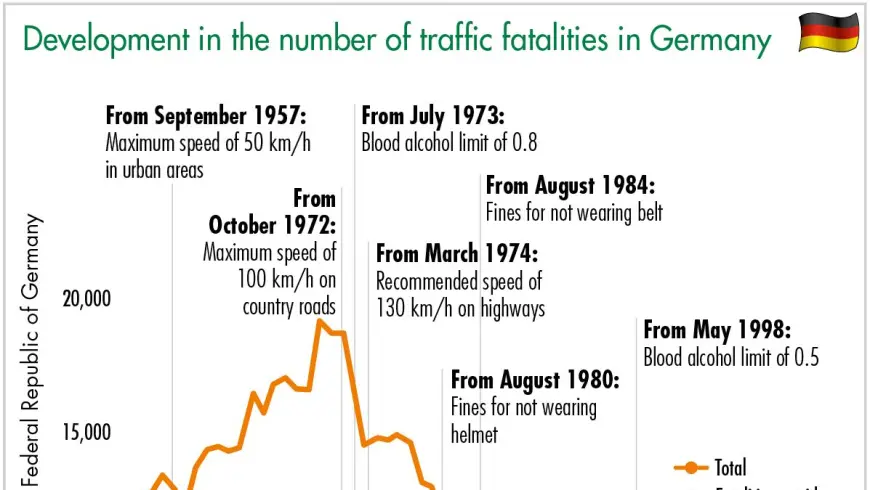EU placing more focus in serve injuries
According to information from the EU Commission, statistically, for every traffic fatality that occurs, a great many more people will suffer severe, ofen life-changing injuries. Not only do severe injuries occur more frequently, they also entail significant costs for society due to the lifelong need for rehabilitation and care. It is the more vulnerable road users such as pedestrians, cyclists, motorcyclists and the elderly who are particularly affected.
Since 2015, member states have been reporting data on severe injuries based on a new, mutually agreed definition in accordance with medical standards. The EU uses the international AIS code (Abbreviated Injury Scale) to define severe injuries in traffic accidents. Injuries classified as 3 or above (MAIS3+) are defined as severe injuries. This can sometimes result in significant deviations from the Figures for “severely injured” road users previously collated differently at a national level.
In November 2016, the Commission published data on the severity of injuries from 16 member states: Belgium, the Czech Republic, Germany, Spain, Ireland, France, Italy, Cyprus, the Netherlands, Austria, Poland, Portugal, Slovenia, Finland, Sweden and the United Kingdom. Based on the data available, it is assumed that around 135,000 people suffer severe injuries on the road in the EU occuevery year, meaning that for every traffic fatality in the EU, 5.2 people are seriously injured. The road users who are particularly at risk also make up a disproportionate number of those seriously injured – this includes pedestrians, cyclists, motorcyclists and, in most cases, the elderly.
2016 Traffic accident statistics for Germany
According to preliminary figures from the Federal Statistical Office, in 2016 Germany recorded the highest number of accidents since reunification, with police recording around 2.6 million accidents (2.8% higher than the previous year). 2.3 million accidents involved material damage, and people were injured or killed in 308,000 of the accidents. In total – also according to preliminary figures – 3,206 people lost their lives in traffic accidents in Germany in 2016. That equates to 253 fatalities or 7.3% less than in 2015, when 3,459 fatalities were recorded, meaning that the number of traffic fatalities reached its lowest level for over 60 years (Figure 10). In terms of absolute figures, the picture within Germany is very varied. According to estimates, the biggest decrease was in Baden-Württemberg with -78 people (-16.1%), followed by Brandenburg with -58 people (-32.4%). There were increases in the city states of Hamburg (+9/+45%) and Berlin (+8/+16.7%), as well as in Saarland (+3/+ 9.7%), Schleswig-Holstein (+7/+6.5%) and Bavaria (+2/+0.3%). The exact circumstances behind this overall development in accidents are not yet available, according to statements by the Federal Statistical Office. However, the decrease in the number of traffic fatalities in 2016 can be attributed to the generally unfavorable weather during the First half of the year.
The current detailed figures for January to December 2016 show that much fewer motorcycle and motor scooter riders were killed in traffic accidents (-99 fatalities = -15.7%). The number of car occupants killed also decreased (-170 fatalities = -6.5%). However, more people were killed on mopeds and motor-assisted bicycles (+6 fatalities = +8.5%) and on bicycles (+8 fatalities = +2.5%). The increase in the number of cyclists killed can be attributed to the huge popularity of pedelecs and the fact that they are, in turn, more frequently involved in accidents (61 fatalities = +70% in total compared with 2015). In accidents involving trucks weighing more than 3.5 metric tons, 40 more people lost their lives in 2016 than in 2015. In accidents involving trucks weighing less than 3.5 metric tons, however, 56 fewer fatalities were recorded.
Most road users were killed on rural roads (1,855). In urban areas, the number of fatalities was 958, while 393 people were killed on highways. In accidents resulting in personal injury, almost 370,000 cases of driver error were recorded. The most common cause was driver error during left/right turns, U-turns or when reversing (almost 58,000), followed by nonobservance of right of way (almost 53,500), insufficient distance (51,200) and excessive speed (almost 47,000). Although it is not possible to determine how many accidents were caused by drivers being distracted by cellphones and similar because there is no way to verify this, it it likely to be a not-insigni ficant figure.

